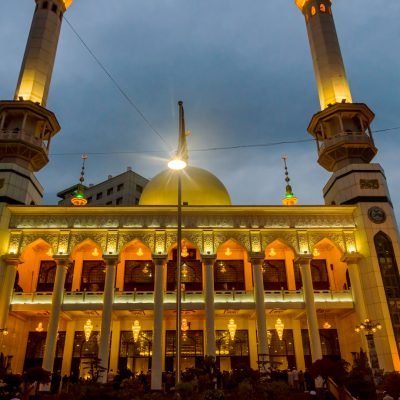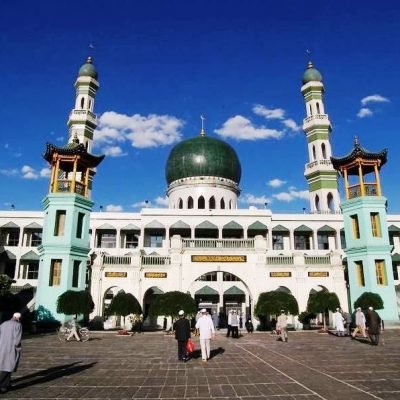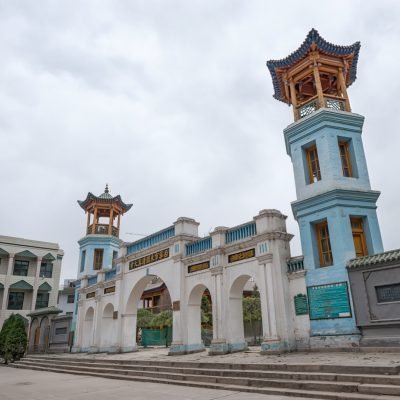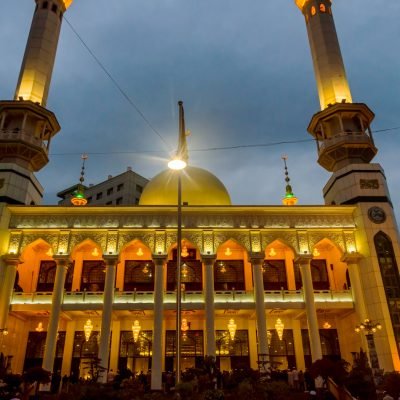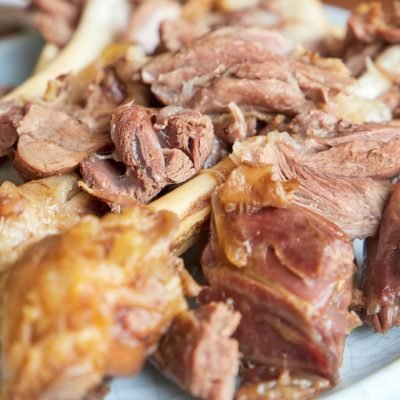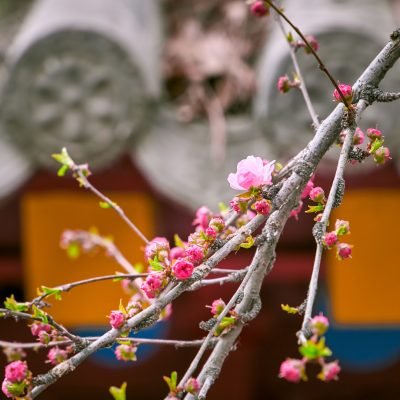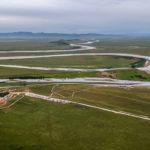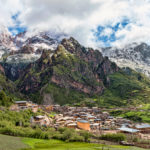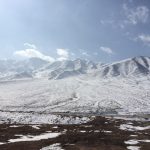Introduction to Dongguan Grand Mosque
Seated in middle eastern part of Xining (no pun intended) in the south of Dongguan Street, the Dongguan Grand Mosque (dōng guān qīng zhēn dà sì 东关清真大寺) is one of the largest mosques in northwest China. During Ramadan this Mosque is home to the 3rd largest gathering of Muslims in the world, only surpassed by Mecca and Medina with larger numbers of devout Islamic followers.
First built in 1379 during the Ming Dynasty (1368-1644), the Dongguan Grand Mosque enjoys a long history of more than 600 years and still remains a very well preserved ancient building. The design of the mosque combines traditional Chinese style with distinctly middle eastern features and patterns. Though predominately Islamic in style, there are a few interesting elements that whisper of the regions history of Buddhist thought. The two twin minarets at the front gate of the mosque are gifts from the local Kumbum Monastery and the Tibetan style gilded victory banners on top of the main temple are gifts from Labrang Monastery, a 5 hour drive away from Xining.
The Dongguan Grand Mosque maintains a regal appearance with an imposing large face and characteristic green domes. Yet this beautiful sanctuary is set right in one of Xining’s busiest streets in the downtown area of Xining. It is quite a contrast to get off a crowded bus by the Mosque and then walk 30 meters into the peaceful temple with it’s birds singing and trees blowing gently in the quiet reverent breeze. The mosque has a prayer hall which can hold up to 3,000 people. Now this mosque serves as an educational center and institution of higher learning for Islamism, and also is the leading mosque in Qinghai.
As one of the four major Mosques in the Northwest region of China, The Dongguan Grand Mosque is the largest and complete ancient building kept in Xining City (xī níng shì 西宁市). Situated in Dongguan Street (dōng guān jiē 东关街), Xining City, Dongguan Mosque is the biggest mosque in Qinghai Province (qīng hǎi shěng 青海省). It was built in 1380, and now boasts a history of more than 600 years. The mosque is not only famous for its magnificent architecture but also as a religious education center and as the highest learning institution of Islam.
Temple Architecture
The mosque covers an area of 13,602 square meters now, and the construction area is 4,654 square meters. These buildings have a large scale, and combine the traditional Chinese architectural art with the Islamic architectural form. With the name of the mosque written on it, the gate is 10 meters high and 15 meters wide. Inside the gate there are five arches of 10 meters high and 21 meters wide. After passing the arches, you’ll see a courtyard with an area of 4,490 square meters. In the middle of the courtyard stands the main worship hall, which takes up an area of 1,136 square meters and is a brick-and-wood construction. There are the imam’s room, students’ dormitories, bathrooms and steles in the mosque, too.
There is a complex of traditional Chinese palace-style buildings in the mosque. The gate of the mosque is an elegant archway with the name of the mosque on it. One pavilion-like building of about 8 meters high stands on each side of the courtyard, and is designed for the imam to call the prayers to worship. The prayer hall is the main building in Dongguan Mosque with the area of 1,136 square meters. The mosque has a prayer hall which can hold up to 3,000 people. The main worship hall faces the east. Therefore the prayers can pray facing the holy city of Mecca. Its wall is made of great cyan stones, and its roof is decorated with colored glaze. The ridge of the hall is decorated with Tibetan style Aquarius. The majestic main worship hall resembles a palace of the Han nationality. There are two-storied ambulatory-like wing halls on both sides of the main worship hall. A water hall is built in the mosque for prayers to wash their hands and feet before entering the worship hall. Islamite worships every Friday. Since the Mosque was built, it has become an important place of worship and assembly for Muslims. When Islam’s important festivals come round, tens of thousands of the Prophet’s followers come to participate in ceremonies and religious activities.
The prayer hall is the main building in Dongguan Mosque, covering 1,136 square meters (about 0.3 acres). The magnificent building can hold about 3,000 worshippers. Since the mosque was built, it has become an important place of worship, and when Islam’s important holidays come around, tens of thousands of the faithful come to participate in ceremonies and religious activities. The most famous ceremonies include Jumu’ah and Corban Festival.
History
The Dongguan Grand Mosque in Xining has a long and ancient history. This large scale, beautifully constructed mosque is one of the largest Islamic temples in China and the largest Mosque in North-west China; it is also the main Islamic cultural center in Qinghai. Since 1988 Dongguan has been official recognized as the most Islamic Mosque in China.
The Dongguan Grand Mosque was originally constructed to serve the religious need of the large local Islamic population; many of the streets through the town of Xining also have a strong Islamic flavor. The temple, originally constructed during the Song Dynasty was reconstructed later in the Ming and Qing Dynasties. The temple is complete with several beautiful arched gates, many heavily influenced by European architecture; the floor-space of the temple is over 6,000 sqaure meters.
The temple has all the main characteristics of a typical Mosque, a 58 meter spire, a main prayer room, five main entrances and different areas for men and women, the mosque will usually hold 7,000 for a weekday prayer session, 20,000 on the weekends and over 100,000 on religious holidays and festivals. The Qinghai Aheng Islam College is located in the mosque today.
It is said that the mosque was established at the beginning of the Ming Dynasty (1368-1644). It has undergone several destructions and reconstructions in the history. The existing buildings were rebuilt in 1913, expanded in 1946, and renovated in 1979.
Restored recently, it was built in the 14th century and has colorful white arches along the outside of the wide building. It has a green and white dome and two tall minarets.
Generals Ma Qi and Ma Bufang controlled the Great Dongguan Mosque when they were military governors of Qinghai.
Climate of Xining and Qinghai Province
Xining has also been dubbed the Summer Resort Capital of China owing to its cool summer, with a cold semi-arid climate. Conditions are influenced by the aridity and high altitude. Lows are cold or cool throughout the year, and highs are often more than 15 °C (27 °F) warmer than lows. Monthly daily averages range from −7.4 °C (18.7 °F) in January to 17.3 °C (63.1 °F) in July; the year averages at 6.1 °C (43.0 °F). Rainfall falls mainly from May to September, and the area is often dry and sunny, with nearly 2680 hours of bright sunshine per year.
Islam in Western China
Muḥammad’s choice of Friday as the Muslim day of communal worship was probably based on the pre-Islāmic function of Friday as market day, a natural occasion for dispersed local tribes to gather in a central location. The influence of the Jewish and Christian sabbath was also felt in the institutionalization of the Muslim Friday, though in Islām it was not a day of rest but a convenient setting for the special religious service. In the modern period, however, most Muslim countries have designated Friday as the legal day of rest; Turkey, following Western tradition, has made Sunday the holiday.
Jum’ah (zhǔ má rì 主麻日), Friday of the Muslim week and the special noon service on Friday that all adult, male, free Muslims are obliged to attend. The Jum’ah, which replaces the usual noon ritual prayer (ṣalāt aẓ-ẓuhr), must take place before a sizable number of Muslims at one central mosque in every locality. Jum’ah is a great time to visit the Dongguan Grand Mosque as there is a gathering of 1000’s of Muslims and their prayer carpets. The whole square gets quite electric at 12 noon every Friday and this is a great time to witness the full character of Islam in China.
Corban Festival, the 2nd Most Important Islamic Holiday
The Corban Festival (gǔ ěr bāng jié 古尔邦节), an annual major traditional Islamic festivals, falls on the tenth of the twelfth month of the Islamic calendar and is celebrated by Chinese minority nationalities that believe in Islam, including Hui (huí zú 回族), Uygur (wéi wú ěr zú 维吾尔族), Kazak (hā sà kè zú哈萨克族), Ozbek (wū zī bié kè zú 乌孜别克族), Tajik (tǎ jíkè zú 塔吉克族), Tartar (tǎ tǎ ěrzú 塔塔尔族), Kirgiz (柯尔克孜族), Salar (sǎ lā zú 撒拉族), Dongxiang (东乡族) and Bonan (保安族). It is called Eid-al-Adjha in Arabic. Eid means festival and Adjha means sacrifice. Therefore this day is also called Corban.
According to Islamic legend, once in a year, Muslims slaughtered a certain number of cattle and donated them to other people so as to show their sincere faith in Allah. Ibrahim, a prophet, once promised in public that he would slaughter his son as a sacrifice if Allah asked him to do so. In a dream, Ibrahim got Allah’s divine message for him to practice his promise by slaughtering his son as a sacrifice. The dream repeated several times and finally, Ibrahim painfully made up his mind. On the next day, the tenth day of the final month according to the Islamic calendar, a tearful Ibrahim took his son to a hilltop. When he was about to carry out the order, a messenger sent by Allah descended with a sheep, and asked Ibrahim to sacrifice the sheep instead of his own son. Since then the Muslims have been marking the day by slaughtering sheep. This gradually evolved into the Corban festival, one of the most important Islamic festivals.
During Corban, all Islamic families would clean up their houses and be busy making various cakes for the festival. All families that possess cattle exceeding a certain number would butcher some sheep, camels or oxen. It is regulated that the sheep to be slaughtered must be fostered more than one year and the oxen, more than two years. These families could keep one-third of the slaughtered cattle for themselves and distribute the rest to the poorest people and relatives.
The Bathing Festival has at least seven or eight hundred years of history in Tibet where prevails many legends about its origin. Here is one of the stories: Once upon a time, there was a great doctor living in Tibet called the Medicine King due to his magic skill. When he died, be became a god living in the heaven. One year, a terrible epidemic struck the whole Tibetan area, killing numerous people and cattle. Tibetans then turned to the Medicine King, praying for his help to relieve their distress. When the Medicine King heard their praying, he turned himself into a bright star. When the star shone over the hills, all plants on the hills became medicine. When the star shone over the rivers, the water in the river was turned into medicine liquid, too.
In the morning of Corban, Islamic people would tidy their clothes after taking a bath and listen to imams’ interpretation of Koran in the mosques. It is the largest gathering in the mosques throughout a year. After prayers and rites, all the families will go to graveyard to pay tribute to their late beloved on the day.
Meanwhile, Corban also provides an optimum opportunity for conversation during which many Islamic people get together and share mutton, cakes, melons and fruits with others.
In Xinjiang Uygur Autonomous Region (xīn jiāng wéi wú ěr zú zì zhì qū 新疆维吾尔自治区), Muslims are given three days as holidays to celebrate the Corban Festival. In Ningxia Hui Autonomous Region (níng xià huí zú zì zhì qū宁夏回族自治区), all the government staff and employees, no matter they are Muslims or not, are given one day leave on Corban. Islamic associations across China also organize gatherings during the Corban Festival.
Location: In Dongguan Street, Sining, Qinghai Province
Tel: 0971-6122987
Transportation:
1. Take flight to Xining Airport or take train to Xining Railway Station first.
2. Take Bus No. 1, NO.2 or No.3 to Dongguan Mosque in Xining Railway Station or take a taxi.
Opening Hours: 8:00-12:00; 14:00-17:00
Recommended traveling time: From a half to a whole day.
Travel Tips: Female can’t enter the prayer hall. Besides, the consumption of pork is prohibited in the temple.
Nearby Attractions
 Kumbum Monastery is one of the six great Gelukpa sect monasteries in Tibet. The others are Ganden (70 minutes outside Lhasa), Sera (Lhasa), Drepung(Lhasa), Tashilhunpo (Shigatse) and Labrang(Xiahe). Kumbum monastery is located 26km / 16 miles from Xining (known as Silang in Tibetan) in northeast Amdo. Though it is now known as being one of the biggest Chinese tourist attractions in the area, Kumbum has been a very important monastery in Tibetan history.
Kumbum Monastery is one of the six great Gelukpa sect monasteries in Tibet. The others are Ganden (70 minutes outside Lhasa), Sera (Lhasa), Drepung(Lhasa), Tashilhunpo (Shigatse) and Labrang(Xiahe). Kumbum monastery is located 26km / 16 miles from Xining (known as Silang in Tibetan) in northeast Amdo. Though it is now known as being one of the biggest Chinese tourist attractions in the area, Kumbum has been a very important monastery in Tibetan history.
Kumbum Monastery is about 27 kilometers southwest of Xining. It is one of the two most important Tibetan Buddhist monasteries outside Tibet itself. Set among flowing wheat fields and fertile hills, Kumbum Monastery evokes an ambience of relaxation and meditation.
Location: Kumbum Monastery is about 27 kilometers southwest of Xining.
Tel: 0971-6122987
Transportation: Kumbum monastery can be easily reached from Xining. On Kunlun Zhong Lu (near Xi Men) there are taxis that will take you the 26km to the monastery for CNY32. This price is per car and not per person. You can also take a bus to the town of Huangzhong (the small town where Kumbum is) for CNY6 per person.
Recommended Golden Time: The best time to go to the monastery is around Losar (Tibetan New Year). Many Tibetans from Amdo come to the monastery during this time. Try and avoid going to the monastery during the summer. Loads of Chinese tourists are there everyday.
Opening Hours: 8:00am-5:00pm
Admission Fee: CNY80 (it was raised from Y35 to Y80 in 2006)
Travel Tips: Photography is prohibited within the monastery temples.
